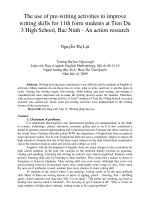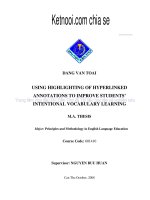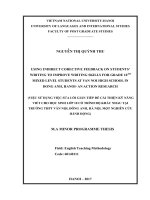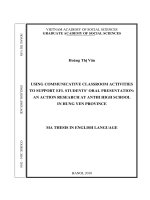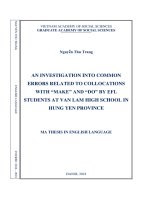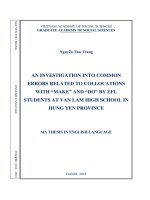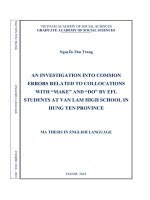Language games as means to motivate students in vocabulary learning at a vocational college in hung yen province an action research project
Bạn đang xem bản rút gọn của tài liệu. Xem và tải ngay bản đầy đủ của tài liệu tại đây (763.41 KB, 92 trang )
VIETNAM NATIONAL UNIVERSITY, HANOI
UNIVERSITY OF LANGUAGES AND INTERNATIONAL STUDIES
FACULTY OF POST-GRADUATE STUDIES
*****************
NGUYỄN THỊ HẢI YẾN
LANGUAGE GAMES AS A MEANS TO MOTIVATE STUDENTS
IN VOCABULARY LEARNING AT A VOCATIONAL COLLEGE
IN HUNG YEN PROVINCE: AN ACTION RESEARCH PROJECT
(Trị chơi ngơn ngữ như một phương tiện để thúc đấy sinh viên học từ vựng
tại trường Cao đẳng Nghề ở Tỉnh Hưng Yên: Một nghiên cứu hành động )
M.A. MINOR THESIS
Field: English Teaching Methodology
Code: 8140231.01
Hanoi-2020
VIETNAM NATIONAL UNIVERSITY, HANOI
UNIVERSITY OF LANGUAGES AND INTERNATIONAL STUDIES
FACULTY OF POST-GRADUATE STUDIES
*****************
NGUYỄN THỊ HẢI YẾN
LANGUAGE GAMES AS A MEANS TO MOTIVATE STUDENTS
IN VOCABULARY LEARNING AT A VOCATIONAL COLLEGE
IN HUNG YEN PROVINCE: AN ACTION RESEARCH PROJECT
(Trị chơi ngơn ngữ như một phương tiện để thúc đấy sinh viên học từ vựng
tại trường Cao đẳng Nghề ở Tỉnh Hưng Yên: Một nghiên cứu hành động )
M.A. MINOR THESIS
Field
: English Teaching Methodology
Code
: 8140231.01
Supervisor : Assoc. Prof. Dr. Vo Dai Quang
Hanoi-2020
DECLARATION
I hereby state that I – Nguyen Thi Hai Yen , being an M.A. candidate
of the Faculty of Post-graduate Studies, ULIS, VNU, certify my authority of
the study entitled “Language games as a means to motivate students in
vocabulary learning at a vocational college in Hung Yen province : An action
research”. This thesis is the study of my own research and the substance of
the thesis has not, wholly or in part, been submitted for a degree to any other
universities or institutions.
Hanoi, 2020
Nguyen Thi Hai Yen
Approved by
SUPERVISOR
(signature and full name)
Assoc. Prof. Dr. Vo Dai Quang
Date:...........................................
i
ACKNOWLEDGMENTS
First of all, I would like to express my sincere gratitude to my
supervisor, Associate Professor Vo Dai Quang, Ph.D. for his precious
instructions and valuable advice throughout the research. Without his careful
guidance, feedback, and patience, my thesis could not have been completed.
I am thankful to staff members of The Post – Graduate Studies Faculty
as well as my lecturers at VNU University of languages and foreign Studies National University during my M.A. course for their help and useful lectures.
Also, great thanks are given to the students at Mecha Electric and
Water Resources Vocational College, who have actively participated in my
study.
Last but not least, I would like to thank my family members for their
love, assistance, and encouragement spared for me throughout the research.
ii
ABSTRACT
Vocabulary is one of the linguistic features which influence communicative
competence. However, when teaching and learning vocabulary, most teachers
and students are confronted with a wide range of obstacles. This study aims at
investigating the problems encountered by students in vocabulary learning
and the effective methods to help them improve their vocabulary in the
learning process at a Vocational College in Hung Yen. Questionnaires, tests,
and interviews were employed as the data collection instruments. The
collected information revealed that the use of language games can help to
improve the students‟ motivation and positive attitudes. On the other hand,
motivation by language games in students comes from the feeling of pleasure,
relaxation, tension-releasing, anxiety-reducing, and curiosity. Students‟
perspectives towards language games in vocabulary lessons are positively
proved by raising the level of activeness, concentration when taking part in
language games. They can also get higher scores after taking part in a
vocabulary lesson easily. Based on the major findings, a couple of
suggestions and recommendations are proposed to improve the quality of
learning vocabulary at the vocational college.
iii
TABLE OF CONTENTS
DECLARATION ............................................................................................. i
ACKNOWLEDGMENTS ............................................................................. ii
ABSTRACT ................................................................................................... iii
LIST OF TABLES ....................................................................................... vii
LIST OF FIGURES AND CHARTS ......................................................... viii
CHAPTER 1: INTRODUCTION ................................................................ 1
1.1. Rationale of the thesis ............................................................................... 1
1.2. Aims and objectives of the thesis .............................................................. 1
1.2.1. Aims of the thesis ................................................................................... 1
1.2.2. Objectives of the thesis .......................................................................... 1
1.3. Research questions .................................................................................... 2
1.4. The scope of the thesis .............................................................................. 2
1.5. Significance of the research ...................................................................... 2
1.6. Organization of the thesis .......................................................................... 2
CHAPTER 2: LITERATURE REVIEW ..................................................... 4
2.1. Vocabulary learning .................................................................................. 4
2.1.1. Definition of Vocabulary ....................................................................... 4
2.1.2. Classification of vocabulary ................................................................... 5
2.1.3. The importance of learning vocabulary ................................................. 7
2.1.4. Difficulties in Vocabulary learning ........................................................ 8
2.1.5. Learning vocabulary in Vocational college context .............................. 9
2.2. Language Games ....................................................................................... 9
2.2.1. Definition of language games ................................................................ 9
2.2.2. Classification of language games ......................................................... 10
2.2.3. The importance of language games in learning vocabulary ................ 11
iv
2.3. Previous studies ....................................................................................... 16
2.3.1. Studies in an international context ....................................................... 16
CHAPTER 3: RESEARCH METHODOLOGY ...................................... 22
3.1. Research context ..................................................................................... 22
3.1.1. Participants ........................................................................................... 22
3.1.2. Textbook ............................................................................................... 23
3.2. Research design ....................................................................................... 23
3.3. Data collection instruments ..................................................................... 24
3.3.1. Questionnaires ...................................................................................... 24
3.3.2. Interview ............................................................................................... 26
3.3.3. Tests ..................................................................................................... 27
3.4. Data analysis techniques ......................................................................... 29
3.4.1. Data analysis from questionnaires ....................................................... 29
3.4.2. Data analysis from interview ............................................................... 29
3.4.3. Data analysis from tests ....................................................................... 29
3.5. Research procedure ................................................................................. 29
CHAPTER 4: FINDINGS AND DISCUSSION ........................................ 33
4.1. Findings and discussion from the students‟ questionnaires .................... 33
4.1.1. Finding and discussion from the pre-task questionnaire ..................... 33
4.1.2. Finding and discussion from the post-task questionnaire .................... 39
4.2. Findings and discussion from an interview ............................................ 46
4.2.1. Findings and discussion from question 1 ............................................. 46
4.2.2. Findings and discussion from question 2 ............................................. 46
4.2.3. Findings and discussion from question 3 ............................................. 47
4.2.4. Findings and discussion from question 4 ............................................. 47
4.3. Finding and discussion from participants‟ tests ...................................... 48
4.3.1.Data collected from pre-test results ...................................................... 48
v
4.3.2. Data collect from post – test results ..................................................... 49
4.3.3. Comparision between pre-test and post-test results ............................. 49
4.3.4. Summary from tests ............................................................................. 50
4.3.5. Summary from result of pre –task and post – task questionnaires and
interview ......................................................................................................... 50
CHAPTER 5: CONCLUSION ................................................................... 51
5.1. Recapitulation ......................................................................................... 51
5.2. Concluding remarks on the research objectives ...................................... 52
5.3. Limitations of the study .......................................................................... 52
5.4. Recommendations for further study ........................................................ 53
REFERENCES ............................................................................................. 55
APPENDCES ................................................................................................... I
APPENDIX I ..................................................................................................... I
APPENDIX 2 .................................................................................................. V
APPENDIX 3: Pre –test .................................................................................. X
APPENDIX 4: Post -test ............................................................................. XIII
APPENDIX 5: Lesson plan ......................................................................... XVI
APPENDIX 6 .............................................................................................. XXI
APPENDIX 7 ........................................................................................... XXIII
vi
LIST OF TABLES
Table 4.1: The students‟ view on the role of vocabulary in ........................... 33
Learning English ( Question 1) ...................................................................... 33
Table 4.2: The time that students spend on learning vocabulary ( question 3) .... 34
Table 4.3: The common way of presenting vocabulary at secondary school 35
( Question 4) ................................................................................................... 35
Table 4.4: The students‟ biggest difficulties in learning vocabulary ............. 36
Table 4.5: The common way of learning vocabulary after lesson and at home .. 37
Table 4.6 : The students opinion about the benefit of using language games
( Question 1) ................................................................................................... 39
Table 4.7: Students‟ assessment of their classmates‟ support in vocabulary
learning through language game (Question 6) ............................................... 42
Table 4.8: Students‟ involment in language games (Question 7) .................. 43
Table 4.9: Students expectation from the teacher when conducting language
games ( Question 10 ) 45
vii
LIST OF FIGURES AND CHARTS
Figure 4.1: The students‟ attitudes toward learning vocabulary in English
lesson (Question 2) ......................................................................................... 34
Figure 4.2: The students‟ expression about this way ( Question 5) ............... 36
Figure 4.3: This question shows the feeling of students when playing games
in learning vocabulary (Question 8) ............................................................... 38
Figure 4.4: Students‟ understanding and experience about the purpose of
language games and their view of point on them ( Question 9,10) ............... 38
Figure 4.5: The students‟ feeling and attitudes about language games the
teacher uses in every vocabuary lessoon (Question 2) .................................. 40
Figure 4. 6: The students‟ feeling after taking part in language games
(Question 3) .................................................................................................... 41
Figure 4.7: Students‟ evaluation of the effectiveness of learning vocabulary
through language games (Question 5) .......................................................... 42
Figure 4.8: Students‟ preferences of ways organizing language game Question 8 44
Figure 4.9: Students‟ hope in taking part in language game in every vocabulaary
lesson ( Question 9) ......................................................................................... 45
Chart 4.1: Pretest results ................................................................................ 48
Chart 4. 2: Post-test results ............................................................................. 49
Chart 4.3: Comparision between pre-test and post-test results ...................... 49
viii
CHAPTER 1: INTRODUCTION
This chapter presents the background of the study and the statement of
the problem, the objectives of the study, the research questions, the scope of
the study, the significance of the study, the method of the study, and the
structure of the study.
1.1. Rationale of the thesis
It is common knowledge that vocabulary learning is an important aspect
of foreign language learning. During the time working as a teacher of English
at Hung Yen Mechanical-Electric and Water Resources Vocational Training
College, I can observe the fact that the students at this training institution
encounter a lot of problems in English vocabulary learning. They tend to like
learning English via different types of games. This status quo is one of the
motives that induced me to go further into this area of research.
1.2. Aims and objectives of the thesis
1.2.1. Aims of the thesis
The study is aimed at:
- Exploring weaknesses of students in learning the language
- Finding suitable methods to help the students at Mecha – Electric and
Water resources Vocational College in Hung Yen raising motivation
- Helping students at this training institution to improve their vocabulary
learning.
1.2.2. Objectives of the thesis
The objectives of the research are as follows:
(i)
To find out the problems encountered by students of Mecha –
Electric and Water resources Vocational College in Hung Yen
(ii)
To work out the effectiveness ways to solve these problems.
1
1.3. Research questions
1. What are the problems encountered by students in vocabulary learning
at Hung Yen Mechanical-Electric and Water resources Vocational College?
2. How have the language games solved these problems?
1.4. The scope of the thesis
The thesis is focused on:
(i) Games employable for vocabulary teaching and learning.
(ii) Non-English major students at Hung Yen Mechanical-Electric
Vocational Training College.
1.5. Significance of the research
As can be inferred from the aims and objectives mentioned above, the
results of this thesis, to the extent possible, would facilitate learners in
vocabulary learning. No doubt, the thesis is of practical value in the sense that
it is beneficial to non-English major students at Hung Yen MechanicalElectric Vocational Training College in improving their vocabulary learning.
1.6. Organization of the thesis
The thesis consists of five main parts: the introduction, the literature
review, the methodology, findings and discussions, and the conclusion.
The introduction presents the rationale of the thesis, the aims, and the
objectives of the thesis, the research questions, the scope of the thesis, the
significance of the thesis.
Chapter 1 The introduction presents the rationale of the thesis, the aims,
and the objectives of the thesis, the research questions, the scope of the thesis,
the significance of the thesis.
Chapter
2
The literature review provides
the definitions of
vocabulary, the importance of learning vocabulary, and the definitions of
language games.
2
Chapter 3 refers to research methodology including research context,
research design, and data analysis techniques.
Chapter 4 demonstrates findings and discussions about pre and post-task
questionnaires, pre, and post-tests then the interview from the students about
language games.
Chapter 5 The conclusion summarizes what has been addressed in the
thesis, points out the limitations and suggestions for further thesis.
3
CHAPTER 2: LITERATURE REVIEW
This chapter has introduced the definitions of vocabulary and its
importance. Besides that, the classification of vocabulary and some
difficulties in vocabulary learning were listed to help teachers in finding out a
suitable method to motivate students in vocabulary learning. Significantly,
with an overview of the language games and the benefits when language
games are used in teaching and learning vocabulary. Some previous studies
are referred to the students‟ attitudes in other places. The facts and the study
vocabulary in the international and Vietnamese contexts were also mentioned.
2.1. Vocabulary learning
2.1.1. Definition of Vocabulary
Vocabulary is broadly known as knowledge of words and word
meanings. It is a fundamental part of the language that must be the mastery of
English skills. However, the definition of the word has been, for a long time a major problem for linguistic theory. Up to the present, there are various
definitions of vocabulary based on different points of view about vocabulary.
According to Hornby (1995), vocabulary is all words a person
understands and uses. It is all the phrases in a specific language or the phrases
that people use when they are talking about a particular subject. Saleh (1997:
60) stressed the division of vocabulary into two main categories: concrete
words and abstract words. Ur (1996: 60) claimed that “ vocabulary can be
defined, roughly, as the words we teach in the foreign language”. Learners
often achieve less than their potential and may be discouraged from making
use of language learning opportunities around them such as listening to the
radio, listening to the native speakers, using language in different contexts,
reading, or watching television without an extensive vocabulary and
4
strategies for acquiring new vocabulary, (Jack C. Richard and Willy A.
Renandya, 2002).
Additionally, Harmer (1991) provided a discussion on “ active and passive”
vocabulary: Active vocabulary contains words that students are “able to use
in speech and which they remember” while passive vocabulary mentions
vocabulary items which students can recognize in a text and understand, but
are not able to use them actively.
In conclusion, giving an exact definition of vocabulary is not simple work.
For this study, the researcher herself most agrees with the last one.
2.1.2. Classification of vocabulary
Vocabulary can be classified in many others ways.
Classification by origin
According to the origin of words, there are two types called native
words and loan words. Loan words are words taken from one language and
used in another like abdomen, cookie. Native words are words that are not
borrowed from another language but are inherited from an earlier stage of the
language like the hand, chair.
Classification by level of usage
Vocabulary can be divided into common, literary, colloquial, slang,
technical words according to the level of usage.
Common words or popular words often connect with ordinary things or
activities and make up the biggest part of the vocabulary with its core as basic
word stock. Stylistically, they are neutral and hence appropriate in both
formal and informal writing and speech.
Literary words are chiefly used in writing, formal, and elevated in style
like the word purchase/ buy.
Colloquial words are used mainly in speaking to colleagues or friends
5
and in informal writing. Consider the following examples that illustrate the
difference between the use of common and colloquial words:
Hey Tom! what’s up?. (Colloquial)
Hey Tom! what are you doing? (Common)
Slang words are words of a vigorous, colorful, fictitious, or taboo
nature, invented for specific occasions or uses or derived from the
unconventional use of the standard vocabulary. For instance, all-nighters,
buck, busted.
Technical words are used in various special fields with functions partly
to denote things or processes which have no names in ordinary English, and
most remain essentially foreign to outsiders, even to educated native speakers.
For example psychoanalysis.
Classification by notion
According to the notion, vocabulary consists of two types, function or
structural words and content words.
Function words include categories of words like determiners,
conjunctions, or auxiliaries which serve as grammatical signals or functional
markers. They do not have lexical meaning and belong to a closed system.
Content words are used to name objects, qualities, actions, or states.
They have independent lexical meanings and belong to the open system.
Classification by the usage of the word
In language teaching, vocabulary can be divided into the productive
and receptive vocabulary. Productive vocabulary generally refers to words
which can be produced within an appropriate context and match the intended
meaning of the speaker or signer. As with receptive vocabulary, however,
there are many degrees at which a particular word may be considered part of
an active vocabulary. Knowing how to pronounce, sign, or write a word does
6
not necessarily mean that the word can be used correctly or accurately reflects
the intended message of the utterance, but it does reflect a minimal amount of
productive knowledge.
Classification by the concept of morpheme
Basing on this criterion, there are simple words (i.e. words consisting of one
root morpheme), derived words (i.e. word
2.1.3. The importance of learning vocabulary
Because a limited vocabulary impedes effective communication in a
second language, mastery of vocabulary is also viewed as a critical tool for
second language learners.
Schmitt (2000) stresses that “lexical knowledge is central to
communicative competence and the acquisition of a second language” p. 55).
Nation (2001) further describes the relationship between vocabulary knowledge
and language use as complementary: knowledge of vocabulary enables
language use and, conversely, language use leads to an increase in vocabulary
knowledge. In and out of class, the value of vocabulary is illustrated every day.
Achieving learners have the most adequate vocabulary in the classroom.
Researchers such as Laufer and Nation (1999), Maximo (2000), Read (2000),
Gu (2003), and Nation (2011) and others have realized that the acquisition of
vocabulary is essential for the effective use of the second language and plays an
important role in the development of complete spoken and written texts.
Learning vocabulary products play a crucial role in all language skills (i.e.
listening, speaking, reading, and writing) in English as a second language
(ESL) and English as a foreign language (EFL). Richards (1980) and Krashen
(1989), as cited in Maximo (2000) state many reasons for devoting attention to
vocabulary. “First, a large vocabulary is of course essential for mastery of a
language. Second language acquirers know this; they carry dictionaries with
7
them, not grammar books, and regularly report that the lack of vocabulary is a
major problem‟‟. Oxford (1990) also claims that vocabulary is “by far the most
sizeable and unmanageable component in the learning of any language,
whether a foreign or one‟s mother tongue, because of tens of thousands of
different meanings” Despite these difficulties that language learners face in L2
vocabulary, they still have to deal with it in their examinations as „„vocabulary
has traditionally been one of the language components measured in language
tests‟‟ (Schmitt, 1999, 189).
2.1.4. Difficulties in Vocabulary learning
The first steps in successful teaching vocabulary are to identify the
difficulties faced by students. Thornbury (2004:27) proposes some factors that
make some words more difficult as follows: Pronunciation, Spelling, Length
and complexity, Grammar, Meaning, range, connotation, and idiomaticity.
Words that can be used in a wide range of contexts will generally be
perceived as easier than their synonyms with a narrower range. Thus, put in a
very wide-ranging verb, compared to impose, place, position, etc. Likewise,
thin is a safer bet than skinny, slim, slender. Uncertainty as to connotations of
some words may cause problems too. Thus, propaganda has negative
connotations in English, but its equivalent may simply mean publicity. On the
other hand, eccentric does not have negative connotations in English, but its
nearest equivalent in other languages may be deviant. Finally, words or
expressions that are idiomatic( like make up your mind, keep an eye on…)
will generally be more difficult than words whose meaning is transparent (
decide, watch). Gower, Philips, and Walter(1995: 143) explain what makes a
vocabulary item is easy or difficult. How easy or difficult a vocabulary item is
can depend on several factors: a. The similarity to L1, Similarity to
English words are already known, Connotation, Spelling and
pronunciation, Multi-word items, Collocation, Appropriate use.
8
2.1.5. Learning vocabulary in Vocational college context
First of all, in the vocabulary learning process the students in this
college consider the teachers‟ explanation for the meaning of definition,
pronunciation, spelling, and grammatical functions boring. In this case,
language learners have nothing to do in the vocabulary learning section but to
listen to their teacher. Second, students only think of vocabulary learning as
knowing the primary meaning of new words. Therefore, they ignore all other
functions of the words. Third, the students usually only acquire new
vocabulary through new words in their textbooks or when given by teachers
during classroom lessons. For example, learners find many new words in a
text and then ask the teacher to explain the meanings and usage. Forth, many
learners do not want to take risks in applying what they already “know the
word”, but they may not be able to use that word properly in different
contexts or pronounce it correctly
2.2. Language Games
2.2.1. Definition of language games
Vocabulary learning is always a hard task for language learners. It is
now very generally accepted that language teaching and learning not merely
can be but should be enjoyable. This means that there is no need, by
excluding enjoyment, to make it more difficult. Many linguists agree that
playing language games is a good way of learning vocabulary. So what is the
concept of games and language games?
There are a wide variety of definitions of games in language teaching.
As defined in “ Longman Dictionary of Language Teaching and Applied
Linguistics” ( Richard & Schmidt, 2010), games are “ an organized activity”
which usually has the following features “ a particular task or objective”: a set
of rules”, competition between players”, and “ communication between
9
players by spoken or written language” (p.239). Thus, games are useful in
communicative language teaching “CLT”, an approach that has recently
increased in popularity. Hadfield (2005) defined games as “ an activity with
rules, a goal, and an element of fun” (p.5). Through these two definitions, it is
reasonable to conclude that games are used in the classroom, students are
given an exciting opportunity to learn English in a more relaxed atmosphere.
Lee, W. R. (1979) defined games in the strict sense, which have a
definite beginning and are governed by rules, shade off into game-like
activities which have a less formal design.
Byrne (1995) gave the definition to games as a form of play governed
by rules. They should be enjoyable and fun. They are not just a diversion, a
break from routine activities, but a way of getting the learner to use the
language in the course of the game. Therefore, games involve many factors:
rules, competition, relaxation, and learning, in particular. The main focus of
using games in class is to help students learn and have fun.
Therefore, Games include many factors: Rules, relaxation, competition,
and learning. It means that It helps students learn and have fun.
2.2.2. Classification of language games
According to Hadfield (1984), language games can be divided into two
types: linguistic games and communicative games. Linguistic games focus on
accuracy, such as supplying the correct antonym. In contrast, communicative
games focus on the successful exchange of information and ideas. Games can
be competitive (players or teams race to be the first to reach the goal) or cooperative (players or teams work together towards a common goal).
Besides, Hadfield suggested another way of classifying language games
which are based on categories. Following this, there are other types of
language games such as sorting, ordering, or arranging games, information
10
gap games, guessing games, search games, matching games, labeling games,
exchanging and collecting games, board games, role play games.
Basing on language knowledge and skills that learners need to master,
Lee, W. R (1979) divided games into structure games (games provide the
experience of the use of particular pattern of syntax in the communication),
vocabulary games (games in which the learners‟ attention is focused mainly on
words, spelling games (games to practice spelling), pronunciation games
(games for practicing pronunciation), number games (games help learners to
get accustomed to the spoken forms of numbers so that they are not a stumbling
block to communication), listen-and- do- games (games in which students have
to listen and understand, then carry out some action), read-and-do games
(games to practice reading), writing games (games to encourage meaningful
writing practice), discussion games (games involve discussion).
2.2.3. The importance of language games in learning vocabulary
Games help teacher to create contexts in which the language is useful
and meaningful. It can be said that Language games have a fully respected
place in foreign language learning. Games play an essential role because they,
the learners like to play and have fun so by giving the games as a teaching
method, the students can be more excited and motivated to study English.
“Games help and encourage many learners to sustain their interest and work”
( Wright, Betteridge, and Buckby, 2009, P.2) games are not only for fun but
also for encouraging children to seize control of English faster. So Language
games are important for all the reasons below.
Games improve vocabulary retention
According to Richards and Schmidt (2010), retention is defined as
“The ability to recall or remember things after an interval of time ” (p.498). In
language teaching, there are three contributing factors to retention in general
11
and vocabulary retention in particular, namely teaching quality, learners‟
interest, and the meaningfulness of the materials. Certainly, games, which
belong to the materials, affect vocabulary retention.
Games increase motivation
Obviously, games enhance students‟ motivation, which means “ the
driving force in any situation that leads to action” in general and in the field
of language learning refers to “a combination of the learners‟ attitudes, desires
and willingness to expend effort in order to learn the second language” (
Richards & Schmidt,2010, p. 377). It is undeniable that fun and challenge are
the core components of language games. Thanks to the former, students can
learn in a more relaxed atmosphere and they can show a deeper interest in the
lesson because of the diversity in classroom activities added by games. With
the help of the latter, students can communicate and cooperate with their
peers in pairs or groups and simultaneously compete with others to become
the first to win. Moreover thanks to games, motivation among young learners
can be improved by the internal element, for example, interest and external
element, for motivating learners by providing fun and challenge.
Games sharpen teamwork skills
Teamwork refers to “a cooperative process that allows ordinary people
to achieve extraordinary results” and skill is defined as “an acquired ability to
perform an activity well, usually one that is made up of the number of
coordinates processes and actions” (Richard & Schmidt, 2010, p. 532). As can
be seen from the aforementioned definitions, teamwork skills are thought to
be skills aimed at facilitating the activity of working together in which
teammates are required to cooperate in order to achieve common goals.
Among essential teamwork skills are communication, conflict solution,
listening, dependability, and respectfulness. Games support communication
12
among pupils by requiring the players to express their own opinion and
discussing them with their teammates. However, in the process of games,
conflict may arise in the context of the selection of the most satisfactory
answer from different ones offered by every teammate. Consequently,
negotiation must start in the process of exercising the most viable option,
through which conflict can be settled. Conflict management is equal to a
willingness to take notice of every member‟s answer, which means the
existence of listening. In order to reach complete agreement, teammates need
to put their trust in one another after asking questions for clarification. Any
member who has contributed their idea deserves to be appreciated. In short,
games can enhance teamwork skills, namely communication, conflict
solution, listening, dependability, and respectfulness.
Games provide active learner-centered learning and meaningful
practice
In addition, games “ provide opportunities for real communication” and
“ constitute a bridge between the classroom and the real world” ( Hadfield,
2005, p.5). With the use of the games, teachers are able to create a wide
variety of contexts in which students are required to use the language to
communicate, exchange information, and express their ideas and opinions.
Games enhance confidence
Thanks to the fun inherent in games, students can learn in a more
relaxed atmosphere and they can show a deeper interest in the lesson because
of the diversity in classroom activities added by games. Moreover, in the
process of games, the focus is on the communication in the target language,
no on error correction, which is thought to lead to increased confidence in
lessons. It is clear that games provide a meaningful context in which pupils
are required to respond to challenge. Therefore, their level of confidence is
13
undeniably enhanced by expressing and discussing opinions with each other
and simultaneously practicing the language without fear of continuos
correction in order to deal with the challenge set up by games on the way to
earning a win.
Games foster student-students and student-teacher relationship
Games can be used as pair work, small group work, or whole class
activities. In the process of games students within a group are encouraged to
express and exchange their opinions with each other. It is cooperation that
helps students to better understand each other. Furthermore, when competing
with other teams, all differences are put aside and the only thing to exist
among students is cooperation promoted by sharing experience and
knowledge, which indisputably leads to a closer bond between classmates.
When students perceive the teacher is playing language games with them, the
learner-teacher bond must be strengthened.
The game provides a meaningful context
According to Wright, Betteridge & Buckby (2009), games also help the
teacher to create contexts in which the language is useful and meaningful.
Children are provided good reasons to revise what they have learned by
language games. With the regular revising method, the children do their
exercise, listen to the teacher‟s summary, and rewrite it down. They have no
chance to show themselves in from of class, which will make them confident
to use what they have learned. However, with language games, the learners
stand up and come out of their seats to revise language items differently. The
go-to the board, give answers, do the action in a competitive but friendly
atmosphere, sometimes with smiles and fun.
This way of revising helps learners to remember easily without any
reluctance or difficulties. He does repetition all the time but they do not
14
realize it because each time they repeat, the so it in different ways. As in “
guessing game” with action while speaking out of the phrases every turn, and
the whole class is divided into teams will check and give an evaluation.
Whenever they do action, they speak, check, and evaluate, that is when they
repeat language items without boredom. With the regular revising method, the
interaction in the classroom is often taught to the whole class, which makes
learners passive in the process of receiving input. To some certain extend,
learners are familiar with their teacher, but they still feel less confident and
reluctant when expressing what they have learned or when being required to
stand up and fulfill the task.
Games can be a very good way to practice real-life skills. According to
Lewis (1999), the context of the game makes the foreign language
immediately useful to children. It brings the target language to life. The
reason most people want to learn a language is to be able to use it in real-life
situations, for example, they go traveling to other countries, they have to
communicate with local people and what will happen if they cannot connect
with others. Games can be a very good method to practice these skills because
they can easily be used to reenact various situations from real life and provide
students with practice in their fluency. Also, by using games in the classroom
the teacher is giving his or her learners a bigger role, and they are stepping out
of the frontline which is a positive thing because it allows students to do more
on their own, and they can have a very well result in an increase in their
confidence level.
Games provide a logical contribution while learners interact in the
group, allowing students to clarify the meaning of the words. This strategy
enhances learners‟ enthusiasm to learn new English vocabulary. According to
Hansen (1994,p.118 cited in Nguyen Thi Hue Linh,2009) games are not time15
